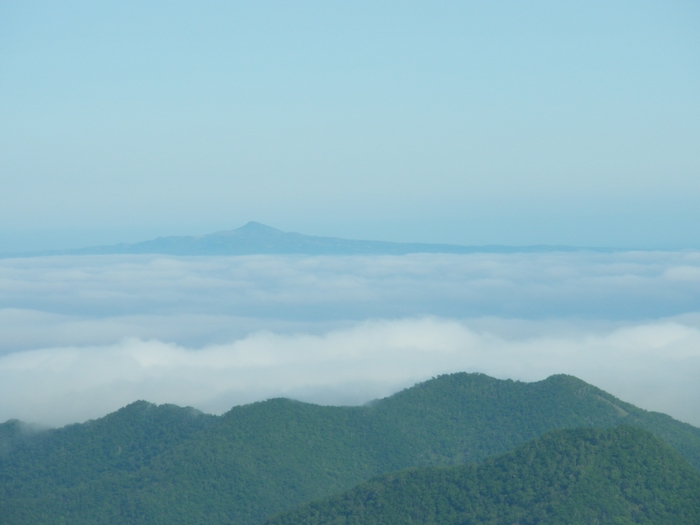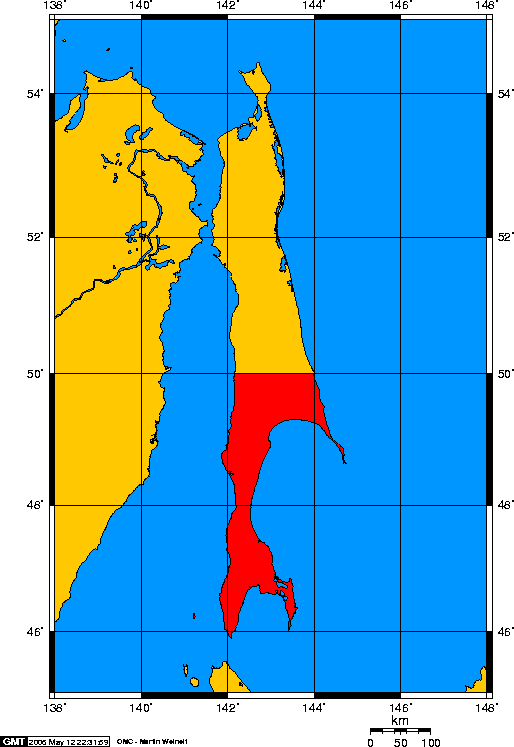|
Japan–Russia Border
The Japan–Russia border is the ''de facto'' maritime boundary that separates the territorial waters of the two countries. According to the Russia border agency, the border's length is . The two countries do not share a terrestrial border, although they did during the period 1905–1945 when the island of Sakhalin was split between Japan and the Russian Empire (and later the USSR). History The border between Russia and Japan has changed several times over the last 200 years. The Treaty of Shimoda (1855) divided the Kuril Islands, creating a maritime boundary between the Japanese Etorofu (Iturup) in the south and the Russian Urup in the north. The treaty did not determine the status of Sakhalin. The Treaty of Saint Petersburg (1875) assigned Sakhalin Island to Russia and all of the Kurile Islands to Japan. Thus during the following 30 years the maritime border between the two empires ran along the La Pérouse Strait (between Hokkaido and Sakhalin) and the Kuril Strait (between ... [...More Info...] [...Related Items...] OR: [Wikipedia] [Google] [Baidu] |
Kuril Strait
First Kuril Strait (, ) (also known as just Kuril Strait) is a strait, located at , separating the Shumshu Island of the Kuril Islands from the Cape Lopatka, Kamchatka Peninsula. See also * Second Kuril Strait * Fourth Kuril Strait The Fourth Kuril Strait () is a very deep strait separating the islands of Onekotan and Paramushir in the Kuril Islands, Russia. It is 46.7 km (about 29 mi) wide. It was formerly known as the Amphitrite Strait. The flood tidal current in the strait ... Straits of the Kuril Islands Shumshu Bodies of water of the Kamchatka Peninsula {{SakhalinOblast-geo-stub ... [...More Info...] [...Related Items...] OR: [Wikipedia] [Google] [Baidu] |
Soviet Invasion Of South Sakhalin
The Soviet invasion of South Sakhalin, also known as the Battle of Sakhalin (russian: Южно-Сахалинская операция; ja, 樺太の戦い), was the Soviet invasion of the Japanese portion of Sakhalin Island known as Karafuto Prefecture. The invasion was part of the Soviet–Japanese War, a massive campaign of the Second World War. Background In the Treaty of Portsmouth in 1905, control of the island was split, with the Russian Empire controlling the northern half and the Japanese controlling the portion south of the 50th parallel north. It was known in Japan as Karafuto Prefecture and the Northern District. During the Yalta Conference in 1945, Soviet Premier Joseph Stalin pledged to enter the fight against the Empire of Japan "two or three months after Germany has surrendered and the war in Europe is terminated." That would create another strategic front against Japan, which was deemed necessary to end the war. As a result of their participation, the S ... [...More Info...] [...Related Items...] OR: [Wikipedia] [Google] [Baidu] |
North Korea–Russia Border
The North Korea–Russia border, according to the official Russian definition, consists of of "terrestrial border" and 22.1 km (12 nautical miles) of "maritime border". It is the shortest of the international borders of Russia. Description The terrestrial boundary between Russia and North Korea runs along the thalweg of the Tumen River and its estuary, while the maritime boundary separates the two countries' territorial waters in the Sea of Japan.Северная Корея (North Korea), at the Russia's border agency's (Rosgranitsa) official site The principal border treaty was signed on April 17, 1985. [...More Info...] [...Related Items...] OR: [Wikipedia] [Google] [Baidu] |
Japan–Korea Treaty Of 1910
The Japan–Korea Treaty of 1910, also known as the Japan–Korea Annexation Treaty, was made by representatives of the Empire of Japan and the Korean Empire on 22 August 1910. In this treaty, Japan formally annexed Korea following the Japan–Korea Treaty of 1905 (by which Korea became a protectorate of Japan) and the Japan–Korea Treaty of 1907 (by which Korea was deprived of the administration of internal affairs). Japanese commentators predicted that Koreans would easily assimilate into the Japanese Empire. In 1965, the Treaty of Basic Relations between South Korea and Japan confirmed this treaty is "already null and void". History The treaty was proclaimed to the public (and became effective) on 29 August 1910, officially starting the period of Japanese rule in Korea. The treaty had eight articles, the first being: "His Majesty the Emperor of Korea makes the complete and permanent cession to His Majesty the Emperor of Japan of all rights of sovereignty over the w ... [...More Info...] [...Related Items...] OR: [Wikipedia] [Google] [Baidu] |
Russian Civil War
, date = October Revolution, 7 November 1917 – Yakut revolt, 16 June 1923{{Efn, The main phase ended on 25 October 1922. Revolt against the Bolsheviks continued Basmachi movement, in Central Asia and Tungus Republic, the Far East through the 1920s and 1930s.{{cite book, last=Mawdsley, first=Evan, title=The Russian Civil War, location=New York, publisher=Pegasus Books, year=2007, isbn=9781681770093, url=https://archive.org/details/russiancivilwar00evan, url-access=registration{{rp, 3,230(5 years, 7 months and 9 days) {{Collapsible list , bullets = yes , title = Peace treaties , Treaty of Brest-LitovskSigned 3 March 1918({{Age in years, months, weeks and days, month1=11, day1=7, year1=1917, month2=3, day2=3, year2=1918) , Treaty of Tartu (Russian–Estonian)Signed 2 February 1920({{Age in years, months, weeks and days, month1=11, day1=7, year1=1917, month2=2, day2=2, year2=1920) , Soviet–Lithuanian Peace TreatySigned 12 July 1920({{Age in years, months, weeks and da ... [...More Info...] [...Related Items...] OR: [Wikipedia] [Google] [Baidu] |
Sea Of Okhotsk
The Sea of Okhotsk ( rus, Охо́тское мо́ре, Ohótskoye móre ; ja, オホーツク海, Ohōtsuku-kai) is a marginal sea of the western Pacific Ocean. It is located between Russia's Kamchatka Peninsula on the east, the Kuril Islands on the southeast, Japan's island of Hokkaido on the south, the island of Sakhalin along the west, and a stretch of eastern Siberian coast along the west and north. The northeast corner is the Shelikhov Gulf. The sea is named after the Okhota river, which in turn named after the Even word () meaning "river". Geography The Sea of Okhotsk covers an area of , with a mean depth of and a maximum depth of . It is connected to the Sea of Japan on either side of Sakhalin: on the west through the Sakhalin Gulf and the Gulf of Tartary; on the south through the La Pérouse Strait. In winter, navigation on the Sea of Okhotsk is impeded by ice floes. Ice floes form due to the large amount of freshwater from the Amur River, lowering the salinity o ... [...More Info...] [...Related Items...] OR: [Wikipedia] [Google] [Baidu] |
Strait Of Tartary
Strait of Tartary or Gulf of Tartary (russian: Татарский пролив; ; ja, 間宮海峡, Mamiya kaikyō, Mamiya Strait; ko, 타타르 해협) is a strait in the Pacific Ocean dividing the Russian island of Sakhalin from mainland Asia (South-East Russia), connecting the Sea of Okhotsk on the north with the Sea of Japan on the south. It is long, wide, and less than deep at its deepest point. History Yuan dynasty During the Yuan dynasty, the Yuan armies crossed the strait in the Mongol invasions of Sakhalin. Alleged remnants of a Chinese fort dating back to the Mongol Yuan era can be found in Sakhalin today. "Tartary" is an older name used by Europeans to refer to a vast region covering Inner Asia, Central Asia and North Asia. The toponym is derived from the Medieval ethnonym Tartars, which was applied to various Turkic peoples, Turkic and Mongol semi-nomadic empires, including the Yuan dynasty that ruled over China and the straits of Northeast Asia. Qing dyn ... [...More Info...] [...Related Items...] OR: [Wikipedia] [Google] [Baidu] |
50th Parallel North
The 50th parallel north is a circle of latitude that is 50 degrees north of the Earth's equatorial plane. It crosses Europe, Asia, the Pacific Ocean, North America, and the Atlantic Ocean. At this latitude the sun is visible for 16 hours, 22 minutes during the summer solstice and 8 hours, 4 minutes during the winter solstice. The maximum altitude of the sun during the summer solstice is 63.44 degrees and during the winter solstice it is 16.56 degrees. During the summer solstice, nighttime does not get beyond astronomical twilight, a condition which lasts throughout the month of June. Everyday of the month of May can view both astronomical dawn and dusk. At this latitude, the average sea surface temperature between 1982 and 2011 was about 8.5 °C (47.3 °F). Around the world Starting at the Prime Meridian and heading eastwards, the parallel 50° north passes through: : Sakhalin island From the signing of the 1875 Treaty of Saint Petersburg until the Russo-Jap ... [...More Info...] [...Related Items...] OR: [Wikipedia] [Google] [Baidu] |
Karafuto Prefecture
Karafuto Prefecture ( ja, 樺太庁, ''Karafuto-chō''; russian: Префектура Карафуто, Prefektura Karafuto), commonly known as South Sakhalin, was a prefecture of Japan located in Sakhalin from 1907 to 1949. Karafuto became territory of the Empire of Japan in 1905 after the Russo-Japanese War when the portion of Sakhalin south of 50°N was ceded from the Russian Empire in the Treaty of Portsmouth. Karafuto was established in 1907 as an external territory until being upgraded to an " Inner Land" of the Japanese metropole in 1943. Ōtomari (Korsakov) was the capital of Karafuto from 1905 to 1908 and Toyohara (Yuzhno-Sakhalinsk) from 1908 to August 1945 when the Japanese administration ceased to function in the invasion of South Sakhalin by the Soviet Union after the surrender of Japan in World War II. Karafuto Prefecture was de facto replaced with Sakhalin Oblast, although it continued to exist de jure under Japanese law until it was formally abolished as a lega ... [...More Info...] [...Related Items...] OR: [Wikipedia] [Google] [Baidu] |
Treaty Of Portsmouth
A treaty is a formal, legally binding written agreement between actors in international law. It is usually made by and between sovereign states, but can include international organizations, individuals, business entities, and other legal persons. A treaty may also be known as an international agreement, protocol, covenant, convention, pact, or exchange of letters, among other terms. However, only documents that are legally binding on the parties are considered treaties under international law. Treaties vary on the basis of obligations (the extent to which states are bound to the rules), precision (the extent to which the rules are unambiguous), and delegation (the extent to which third parties have authority to interpret, apply and make rules). Treaties are among the earliest manifestations of international relations, with the first known example being a border agreement between the Sumerian city-states of Lagash and Umma around 3100 BC. International agreements were used in so ... [...More Info...] [...Related Items...] OR: [Wikipedia] [Google] [Baidu] |
Japanese Invasion Of Sakhalin
The invasion of Sakhalin was the last land battle of the Russo-Japanese War, and took place from 7 July to 31 July 1905. Background The invasion and occupation of the island of Sakhalin had been considered by the Japanese government from the early stages of the Russo-Japanese War, and the plan was actively promoted by General Gaishi Nagaoka, a senior member of the Imperial General Headquarters. However, the plan was vetoed, primarily due to opposition by the Imperial Japanese Navy. On 7 June 1905, shortly after the Battle of Tsushima, U.S. President Theodore Roosevelt met with Japanese diplomat Kaneko Kentarō and the issue was reconsidered. Roosevelt agreed with the Japanese assessment that the invasion and occupation of Sakhalin was now necessary, as only the threat of direct loss of Russian territory would bring Tsar Nicholas II to consider a negotiated settlement to the war.. Japan and Russia had previously shared ownership of Sakhalin; however, the Japanese relinquished ... [...More Info...] [...Related Items...] OR: [Wikipedia] [Google] [Baidu] |







